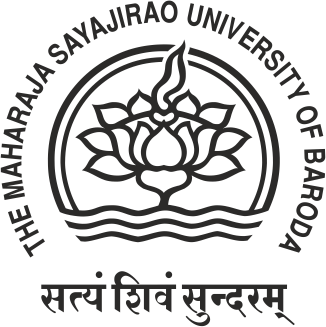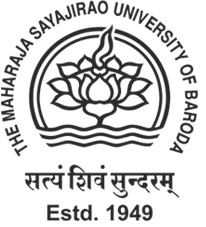Department of Physics:
The department of Physics at the Maharaja Sayajirao University of Baroda was established in 1949. Department is running U.G., P.G. and Ph.D. programmes. In M.Sc., students are offered Solid State Physics, Electronics and Communication, Nuclear Physics and Molecular Spectroscopy as specialization. The department is also equipped by two of the oldest and famous observatories:
(i) Astronomical Observatory and (ii) Meteorological observatory.
A sizable no. of students are being selected for higher studies in premier institutions of India as well as seeking admissions abroad. All members of teaching staff are equipped with Desktop Computer with net facility at their desk and research labs have advanced equipments and work stations of higher configured computers for advanced theoretical work.
The Department had been awarded University Grants Commission’s Department Research Support (DRS) phases I, II & III, and COSIST programs and the Department of Science & Technology had awarded DST-FIST programme in Condensed Matter Physics as thrust research area. Subsequently, University Grants Commission, New Delhi has awarded DSA Phase-I in the thrust areas of Condensed Matter Physics and Nuclear Physics. Various funding agencies have granted over 3.00 cores for supporting ongoing research activities of the individual faculty members, while department has obtained approximately Rs.6 Crores during last five years.
The research interests of the department cover experimental and theoretical Condensed Matter Physics, Material Science, Experimental Nuclear Physics, Spectroscopy, Theoretical Particle Physics and Astrophysics. The research laboratories are well equipped by TDPAC Set up, Mossbauer Spectrometer Set up, Thin Film Coating Unit, Conductivity and Hall-Effect, UV-VIS-NIR Spectrophotometer, Impedance Gain Phase Analyzer, X-ray Diffractometer, Closed Cycle Cryogenic systems (two), Keithly Electrometer, Keithly programmable constant current source and Keithley Programmable Nano Voltmeter, L.C.R.meter (Agilent) E4980A, Digital single Pan Micro-Balance, Gamma Ray Spectrometer detector, FTIR-4100 Spectrometer, Thermal Analyser (DSC), AFM, Workstations-4, Cluster Computing facility (Supercomputer).
Current research activities of the department is as follows:
(i)Theoretical condensed matter Physics: Model calculations on transport properties and ground state properties of graphene, ab initio calculations on transport through atomic chains and wire optical properties of small clusters and atomic clusters. Results have been published in journals and presented at various national & international conferences.
The first principles calculations based on density functional theory are used to investigate the electronic, mechanical, optical and vibrational properties of variety of materials both at bulk and nanoscale levels including metal clusters, graphene and graphene like materials, semiconductor wires etc. The pressure or strain dependent studies on materials are interpreted in terms of their applications in nanodevices and seismic waves. These approaches are also being used to understand the interaction between the inorganic and biomolecules for their perspective uses in nanoelectronic devices.
(ii)Experimental solid state Physics: work on (a) Crystal growth, Thin film and their characterization (b) Electrical, optical and spectroscopic properties of polymers and their composites, (c) Conduction through ionic conductors, Solid state Ionic Glass materials, NASICON Systems of batteries, Li-Ion polymer nano composite electrolytes, Na-Ion batteries and their radiation effect etc. (d) Photo luminescence studies of nanomaterials for the application of making LEDs. Rare earth doped tungstate nanomaterials were explored for solid state lighting application, Rare earth doped strontiumpyrophosphates have been explored for betairradiated Thermo luminescence Dosimetry. (e) Study of conjugated polymers for low cost electronic and photovoltaic applications (f) Effect of SHI irradiation on polymer nano composites for EMI shielding and gas sources applications and (g) Effect of substitution on multifunctional oxide systems. (h) Research is also being conducted in biomimetics and dynamics of soft materials such as polymers and gels when they are away from equilibrium.
(iii) Particle Physics: Rare B-meson decays to two pseudoscalar nonets using factorization have been studied and the ranges of several parameters related to B-mesons have been narrowed down. Singlet axial-vector coupling constant of a nucleon has been calculated using QCD sum rules in which correlators of two axial-vector currents between one-nucleon states has been studied. Transition form factors of eta and eta-prime mesons is being investigated taking into account finite meson and quark masses and with few other changed parameters.
(iv) Nuclear Physics: The experimental Nuclear Physics activities are being carried out by using national facilities such as Pelletron of TIFR/BARC, Mumbai and IUAC, New Delhi and Variable Energy Cyclotron (VEC) of Kolkatta. (a) The study of fast neutron induced fission and reaction cross-sections for advanced reactors and Accelerator Driven subcritical systems (ADSS) applications (b) Effect of elastic scattering break up / transfer and reaction cross section with heavy nuclei (c) Study of break up / transfer fusion cross section and elastic scattering cross section with weakly bound stable projectiles
(d) Effect of break up on fission/fusion cross section fission anisotropy in 67Li induced reactions with fissile targets, Study of Precise elastic (e) Fission fragments angular and mass distributions of various systems in the medium and heavy nuclei.
For further detail information Pl contact: http://jp.singh-phy@msubaroda.ac.in


